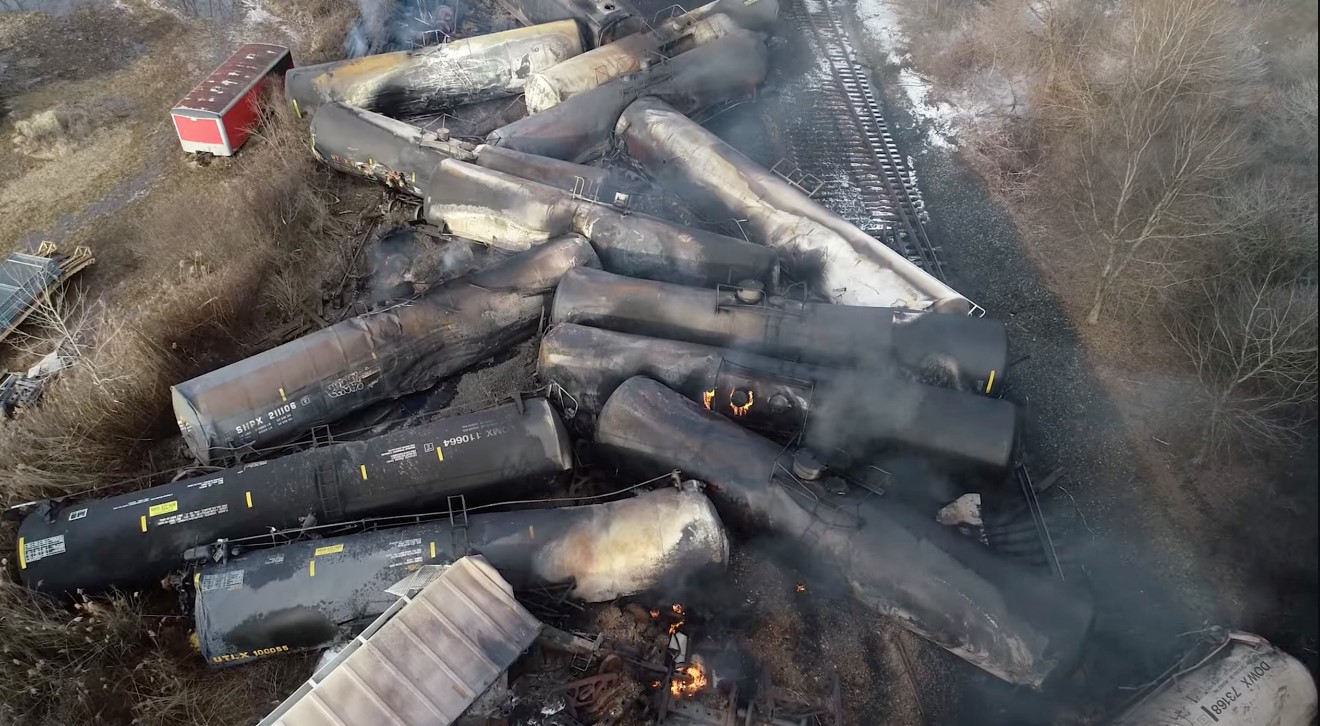by Robert George Armstrong, Oakdale, Minnesota
On February 3, 2023, a Norfolk Southern train carrying hazardous materials derailed near East Palestine, Ohio, a small town with a population of close to 4,700. Although an official investigation by the National Transportation Safety Board has not been completed, early reports suggest that the crash was caused by an overheated wheel bearing. A total of 38 of the train’s 150 cars derailed. Five of them were carrying vinyl chloride, a man-made chemical used in the production of polyvinyl chloride (PVC). As a result of the chemical spill, a large fire broke out. Residents living within a mile of the crash site were ordered to evacuate. Due to fears that rising temperatures inside one of the rail cars containing vinyl chloride could lead it to explode, officials decided to undertake a “controlled release” of the chemical on February 6. This involved digging a trench into which the vinyl chloride was dumped and burned off, producing a plume of dark black smoke. The fire was extinguished on February 8. After tests conducted by the EPA confirmed the air quality was safe, evacuees were allowed to return to their homes.
Although EPA officials have announced the air and water in East Palestine are clean, many of the townspeople are skeptical. At room temperature, vinyl chloride is a sweet-smelling, colorless gas. Inhaling the substance can cause headaches, dizziness, and shortness of breath. Prolonged exposure can lead to liver damage and cancer. Many of the town’s residents have complained of nausea, headaches, and rashes. To address these concerns, Ohio state officials have opened a makeshift health clinic inside a church in downtown East Palestine. The facility’s staff includes nurses, mental health specialists, and toxicologists. Shortly after the chemical spill, 3,500 fish were found dead in local bodies of water. No new incidents of fish kill off have been reported. State officials and the EPA have declared the municipal water is safe to drink. They have urged those with private wells to drink bottled water while they get their well water tested by the EPA and await notification that it is safe to drink. Residents have complained of a thin film covering their houses, which seems to have been a byproduct of the controlled burn. The main concern is what the long-term effects of the train derailment will be – on the residents’ health, on the environment, and on the economy of East Palestine.
On March 4, 2023, another Norfolk Southern train derailed just outside of Springfield, Ohio. Four of the 28 cars that derailed contained only residual amounts of hazardous chemicals. While it may seem like the number of train accidents is increasing, that is actually not the case. According to statistics from the Federal Railroad Administration, approximately 1,000 train derailments occur every year. This number represents a 60 percent decrease in train accidents since 1990. Of course, not every incident involves toxic chemicals. Only 12 of the 1,095 trains that derailed in 2021 were carrying hazardous materials. Hazmat accidents are more likely to happen on highways than they are on railroads.
Two incidents similar to the one in East Palestine occurred in 2005 and 1982. On January 6, 2005, in Graniteville, South Carolina, a Norfolk Southern train collided with a parked train, due to an improperly lined switch. The switch was left in a position that caused the train to be diverted from its scheduled route onto an industry track, where it ran into another train parked in the railyard. This accident resulted in a spillage of 90 tons of liquid chlorine. Nine people died by asphyxiation caused by inhaling chlorine gas. Another 554 people with respiratory issues visited the hospital. A mandatory evacuation was ordered to the approximately 5,400 people living within a one-mile radius of the derailment site. The last evacuees were allowed to return home a week after the crash. Workers were able to prevent gas from leaking from punctured train cars by sealing them with temporary polymer patches. What occurred in East Palestine with the intentional release of vinyl chloride into the ground was avoided in Graniteville. The liquid chlorine was able to be safely pumped out of the train cars carrying it, after which it was mixed with sodium hydroxide solution to neutralize it.
Although it occurred more than 40 years ago, the other incident bears an even closer resemblance to the one which occurred in East Palestine. On September 28, 1982, in Livingston, Louisiana, a train derailed because its conductor and engineer were so inebriated that an unskilled clerk felt she was the only one capable of operating it. The Illinois Central Gulf train consisted of 101 cars, 43 of which derailed. Thirty of the cars that veered off the tracks were carrying hazardous chemicals, including vinyl chloride. The crash caused an explosion, creating a fireball that shot up into the air. An evacuation of residents living within a five-mile radius of the site led to the displacement of 2,700 people for two weeks. Four days after the accident, an explosion in a tank car launched it 600 feet into the air. In order to prevent any similar incidents from occurring, officials decided to release vinyl chloride into the ground and burn it off, just as they did in East Palestine. Close to 200,000 gallons of chemicals including vinyl chloride were spilled as a result of the accident. As part of the remediation efforts, the soil into which the vinyl chloride was dumped was dug out to a depth of 50 feet and replaced with fresh soil. A medical facility was set up in Livingston under the terms of the settlement agreement reached with Illinois Central Gulf. Local residents were allowed to get tested at no cost to them on an annual basis for signs of respiratory ailments or cancer. It appears that the only lawsuits for damages due to long-term effects from chemical exposure were filed on behalf of first responders. More than 40 years later, Livingston does not seem to have suffered any other significant long-term effects. In fact, settlement funds improved the town’s economy in ways that might not have been possible otherwise. A park now stands on the site where the train crash occurred. Based on what happened in Livingston, East Palestinians can expect to be closely monitored for water, air, and health concerns for many years to come. Hopefully, the long-term effects will be more positive for East Palestine than they were for Livingston.
Sources:
Washington Post Derailments aren’t uncommon, but hazmat spills are rare.
Washington Post Investigator Says Clerk Ran Train While Two in Crew Imbibed
Federal Railroad Administration Accident Trends- Summary Statistics
NTSB.gov Railroad Accident Report
Rolling Stone East Palestine Makeshift Clinic Booked Solid as Resident Symptoms Persist
NPR What to know about the train derailment in East Palestine, Ohio
NPR EPA will take control of the East Palestine train derailment cleanup
NBC News ‘Déjà vu’: A train derailment 40 years ago holds clues for East Palestine’s future
Image from Wikipedia



